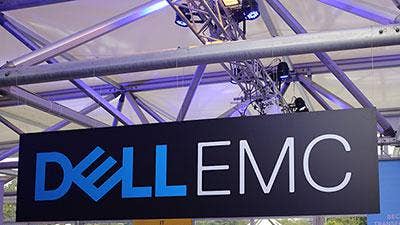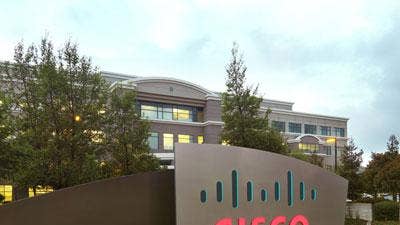CRN Interview: Dell Technologies Networking Chief On The SD-WAN Plan, The Automation Revolution And How Customers Will Crown Market Winners
Tom Burns speaks with CRN about how Dell's networking business is becoming more visible to a wider pool of customers and how solution providers can take advantage of the growing interest in the portfolio.
Open Sesame
Dell Technologies has been preaching the gospel of open networking for several years, and today is poised to bring that belief system to a wider audience.
With the introduction of its Ready Stack solution, and its role in the company's fast-growing SD-WAN strategy, Dell Technologies networking is becoming more visible to a much wider pool of customers, and is noticing a marked increase in the number of solution providers showing interest in its portfolio, said Tom Burns, vice president and general manager of Dell Technologies' networking business.
The company rolled out its Ready Stack offering at the Dell Technologies World conference in Las Vegas Tuesday, and its networking technology plays a key role in bringing the reference architecture system to life.
Burns said Dell Technologies now has all of its customers' networking bases covered, and has an advantage over competitors that have been too slow to adopt an "open" strategy that disaggregates networking hardware from software.

How is Dell Technologies networking business doing in the market, and how is the traditional portfolio doing compared to the next-generation portfolio?
Traditional is probably still around 65 percent of our business, but I'd say 100 percent starts with a conversation around disaggregation, software-defined, customer choice in software and what are the networking trends that are occurring that customers need to be watchful for. We have seen an uptick in the recognition of the benefits of open networking and more interest from partners that we've always had relationships with, but are now embracing that wave even more. We even have some new partners that were heritage EMC partners that are starting to have conversations with us.

Are partners coming over from competitors like Cisco or Juniper?
The demand in the end customer is moving pretty quickly. You see this final realization that software-defined networking can happen, and it's scalable and supportable and there are lots of use cases and proof points. It's the right direction. Everything is going to become software-defined. Customers are starting to make these requests. That has an implication for how channels implement their services and infrastructure. I don't believe some of our competitors are moving quickly enough. They're waking up, and they're seeing it, but even that isn't because it's what they're choosing to do. I think they're being forced to do it. If I look at two of the larger players that you mentioned, one recently announced disaggregation of their service provider software and it would run on white-box switching. That's just being demanded by their customers. It's not their strategic direction, whereas ours was a strategic direction four years ago.

What's your strategy to bring your networking portfolio together with the company's cloud and container portfolios?
If you look at cloud, and we support and endorse hybrid cloud, these particular environments are looking for a level of automation, ease of configuration and consistent tool sets. As we look to our OS-10 development, which is our own stack, or we look at our partners we use on our hardware, we look to those that have complementary interoperability or capability to be used by those same tools. Whether you're going to go container or traditional, software-defined on-prem, you're looking for some consistency around automation, and I think that's how we're driving our strategy. How do we make the network a lot easier for the customer? How do we integrate it from a converged perspective with compute and storage? The customer is really looking at a platform that has tools and methodologies. People are really critical. I spoke with one of our customers today about change management and getting his teams to move away from 'I'm the server guy, I'm the storage guy, I'm the networking girl,' or whatever and now they're a platform team.

What's your outlook for the Ready Stack solution that was introduced at the conference?
It's a reference architecture that incorporates Dell EMC storage, Dell EMC servers, Dell EMC networking, [VMware] vRealize, but also capabilities that will come as time goes on with Red Hat and Microsoft. We're giving our channel partners the capability to document how-to's, to document how to buy, and other information to allow them to extend their services for the do-it-yourself environment. We're really excited about it. We think it's great for our partners to have a new alternative out there in a reference architecture. Their services are an obvious tag onto that.

How big a proportion of your addressable market is that reference architecture customer as opposed to the open, best-of-breed customer?
It's subject to interpretation. The analysts that follow converged infrastructure break it into different components, kind of do-it-yourself or do it for me. This do-it-for-me TAM [total addressable market] is around $6 billion, but the other piece is another $5 billion of do-it-yourself. The reference architecture TAM is huge when it comes to converged infrastructure. If you add on HCI, where our VxRail is, that TAM is exploding. This reference architecture TAM is rather large and still larger than the HCI market, although the HCI market is growing much faster.

How much of that growth do you attribute to customers realizing that not everything has to go to the public cloud, that they're going to get better value with software-defined on-premises?
The growth is coming from the fact that customers are recognizing that they can get a tremendous amount of value and economics out of an on-prem solution. The theory that if I move things off-prem to a public cloud I'm going to save tremendous amounts of cost could be true for certain applications, but for other mission-critical, or other workloads and environments, an on-prem solution is probably the best economics, and I think that market will continue to grow. The public market will grow, but we see customers repatriating out of public cloud and back to on-prem. People are rethinking the economics. We've seen real economics out of solutions around going disaggregated, some going open source, getting support from channel partners around building their stack.

How valuable is that role to channel partners, to be the guy who recommends what gets done with which workloads?
It's a tremendous opportunity from a consulting and professional services standpoint. Enterprises are going through this IT transformation. They're trying to figure out what's the best path to go to get them there. They need a partner to help them who's done real implementations, who's seen the benefits to the customers. And [partners] have the capability to access the portfolio from Dell EMC and stitching that together and implementing it at the customer site. There's tremendous value opportunity for our partners, and they can offer tremendous benefit to enterprises looking for which way to go.

Dell Technologies has a deep relationship with Cisco on one hand, but the companies also compete head-to-head on the other. Is it getting harder to have that kind of relationship? Is it over time leaning toward straight-up competition, or is it being navigated effectively?
Ultimately, the decision is in the hands of the customer. There's a customer base out there that has their current fabric and infrastructure and they want to continue to build upon that. They can look at VxRail, or other components of our portfolio around compute and storage and say I'm going to stay with particular fabric. There are those that want to look for an alternative. With Ready Stack we now have that alternative. Ultimately, the level co-opetition, cooperation or just direct competition is going to be driven by customers. Dell and Dell EMC have always supported doing what's best for the customer, and a lot of it is dependent on their environment, their workloads, or simply their preferences and we can play a significant role with all those pieces.

What do you need from your channel partners now that you're not getting enough of?
I'd like to see our channel partners continue to look at ways to disrupt the market and embrace some of the disruptions that are occurring in networking. Some are embracing open networking. Some are still sticking to the traditional networking proprietary stack. I'd like to see more and more channels look at this as an alternative for their customers. There's the traditional hardware way, but there are other ways, and as a partner they can offer both and let that customer make the decision. Getting trained up and understanding that there's this revolution happening in networking: disaggregation of hardware and software. Look at what's happening with virtualization, with security. Think of the attributes of NSX, VMware's acquisition of VeloCloud, the SD-WAN market is brand new. It's open. It's very disruptive and it's a tremendous opportunity for our partners. Some of them are hosting partners. They have the capability now to host a solution on behalf of medium- or small enterprise and take care of their branch offices. Embracing of the SDX, disaggregated layer 2, layer 3, software-defined, network virtualization, virtual network functions sitting on compute, moving from data center to the edge with SD-WAN is a tremendous opportunity for them. I think many are embracing that. I'd like to see more.

Does all of what you just mentioned bring the networking market to a more flat state? For a long time it was Cisco and everybody else. Do you see the market reaching some kind of equilibrium because of these new technologies?
I absolutely do over the next three to five years. You've seen the progress other vendors have made in the market while Cisco's share is actually below 60 percent now for the first time in many, many years. I think that disruption around the trends in networking are having that implication. I don't think they're moving fast enough. I think they will. They're a smart company that's done extremely well, but they're moving very slowly because they've got this proprietary world that they need to protect. The world of proprietary switching and proprietary software is going to change dramatically in the next three to five years. People should run the protocols and features on the switch that they need, not a full stack. People should use switching hardware that's commoditized, as well as scalable and supported, rather than proprietary hardware. People should look to consolidating automation tools across compute and networking and storage rather than using proprietary automation and management tools for just the switching. I've been in the networking space for a long time. I've never seen more disruption and more change than I've seen in the last year and a half.
How does your organization and VeloCloud play together?
Dell EMC will be the hardware provider for VeloCloud. Anything associated with compute at the edge that they would need to be running either VeloCloud or other VMware services will be coming from Dell EMC. You'll see us resell the VeloCloud solutions as a channel. We also have other partners in the SD-WAN space – we give our customers choice – but I think you'll see a very strong channel pull. From a hardware standpoint, we'll be supporting the VMware VeloCloud team so they can focus on the software and services.